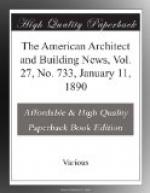We have before called attention to the great and rapidly increasing importance of the South American Republics, and, while there seems to be no prospect that our proximity to them will be of any commercial advantage to us, some of our young architects and skilled mechanics, who speak Spanish, might perhaps find profitable employment there. At present, the most prosperous city is Buenos Ayres, which, from one hundred and sixty thousand inhabitants in 1870, increased to four hundred and sixty thousand in 1888, and has gained very rapidly within the last year. We must confess that our own ideas of Buenos Ayres still retain a reminiscence of gauchos and lassoes and buffalo, but this grows fainter as we find illustrations in the foreign papers of the newer buildings going up in the city. The last we have seen is of an enormous dry-goods store, after the model of the “Bon Marche” or the “Printemps” in Paris, which is known as the “Bon Marche Argentin,” and covers at present ninety thousand square feet of land, while thirty-five thousand feet adjoining have been secured, and are to be used for the enlargement of the present building which will soon become necessary. There are said to be a good many architects already in Buenos Ayres, but first-rate mechanics are, or were not long ago, so scarce that the municipality imported plumbers under contract from London to do work on public buildings.
CIVIL AND DOMESTIC ARCHITECTURE.—I.[1]
The term Civil and Domestic Architecture includes all public and private edifices, that is to say: honorary monuments, such as triumphal arches and tombs; buildings for the instruction of the public, such as museums, libraries and schools; houses for public amusements, as theatres, amphitheatres and circuses; structures for public service, as city-halls, court-houses, prisons, hospitals, thermae, markets, warehouses, slaughter-houses, railway-stations, light-houses, bridges and aqueducts; finally, private dwellings, as palaces, mansions, city and country residences, chateaux and villas.
[Illustration: Memorial to the Heroes of the Franco Prussian War, Berlin.]
The first care of all social organizations, at their inception, must have been to provide shelter against inclement weather. In primitive times society was composed of shepherds, or agriculturists, or hunters, and it is presumable that each of these groups adopted a shelter suited to its nomadic or sedentary tastes. For this reason to shepherds is attributed the invention of the tent, a portable habitation which they could take with them from valley to valley, wherever they led their flocks to pasture; agriculturists fixed to the soil which they tilled, dwelling in the plains and along the river banks, must have found the hut better adapted to their wants, while the hunters, stealing through the forests, ambushed in the mountains, or stationed on the seashore, naturally took safety in caves, or dug holes for themselves in the earth, or hollowed out grottos in the rocks.




